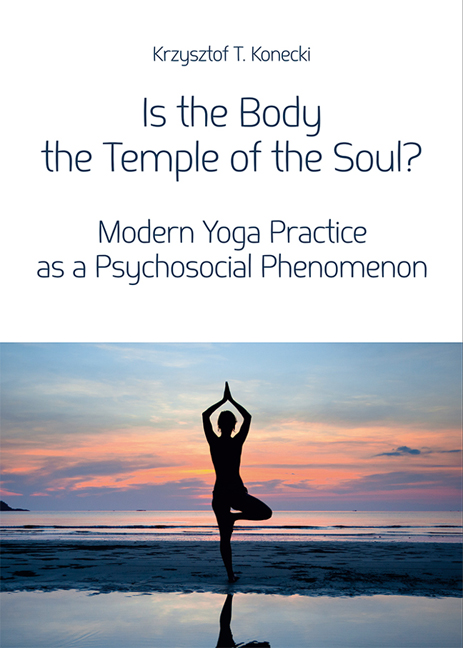
- Publisher:
- Jagiellonian University Press
- Online publication date:
- January 2018
- Print publication year:
- 2016
- Online ISBN:
- 9788323392828
- Subjects:
- Psychology, Health and Clinical Psychology


Reflections and conclusions presented in this book are based on empirical qualitative research. Principles applied in this study coincide with the qualitative sociology model (see Introduction to Konecki, Chomczy?ski 2012), elucidating that both explaining and understanding of social phenomena constitute the underpinnings of qualitative sociology.
Research over the yoga practice - that took place from 2007 to 2011 - started with a participant observation conducted in a yoga studio located in a voivodeship's capital, where the researcher took yoga classes at least once a week. The researcher also conducted four observations of an out-of-town yoga workshop. One of them took place in 2008, when the researcher participated in a one week time stay in the mountains, where yoga was practiced in seclusion for approximately 7 hours a day. The workshop at hand also included meditation and mantra singing. What is more, while conducting this study (2008-2009) the researcher took part in several 3 day out-of-town intensive yoga trainings, where yoga was practiced all day long with only a 4 hour brake (plus meditation in the evening). Thus, the researcher was an active participant of the examined social world. Not only he spent time with individuals being studied, but he also practiced hatha-yoga according to teacher's recommendations. Therefore, his psychical and bodily experiencing of the practice impacted upon the way research questions were formulated during the study. Perceiving all the things that happened during the practice, he started empathizing with other yoga practitioners. The empathizing in question applied to the work over the body while practicing the hatha-yoga positions, the instructions given during the practice, the group meditation, and the joint mantra singing evoking both bodily and psychical experiences. What took place during the joint practice was both the close observation of researcher's experiences and taking the roles of others, thus, the interpersonal empathy, which occurred, facilitated researcher's perception of hatha-yoga notion form others' perspective. Also, the researcher's experiences appeared to be of use while interpreting other kinds of data, which constituted the mainstay for further analysis (e.g., interviews, photographs, video recordings of hatha-yoga practice, observations).
Notwithstanding the importance of researcher's participation in the social world at hand, the understanding of both bodily and mental experiences, which emerge during the practice, needed to be deepened by applying another techniques of data collection. However, putting my experiences in time perspective, I can ascertain that practice and incarnated immersing oneself in the social world of hatha-yoga were both prerequisite for analysis regarding the universe where corporeality seems to act such an important role. Thus, the observation technique entails an outright experiencing of the study participants' world.
Grażyna Woroniecka
 Loading metrics...
Loading metrics...
* Views captured on Cambridge Core between #date#. This data will be updated every 24 hours.
Usage data cannot currently be displayed.